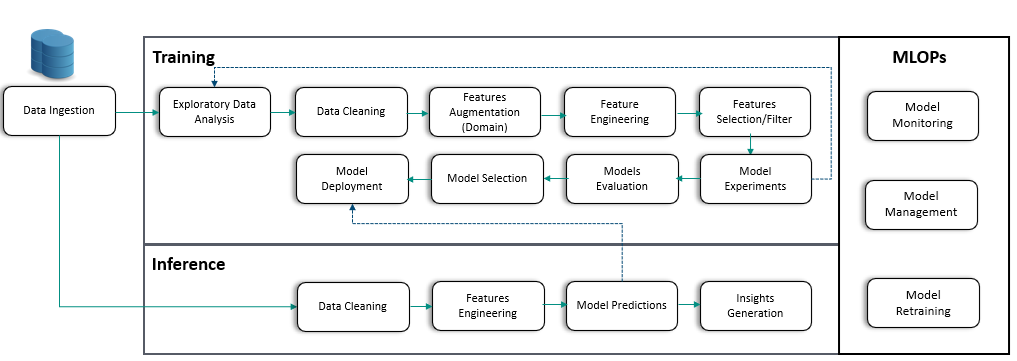Introduction
Today, in the modern era of technological advancement, we often pursue the path of least resistance and maximum efficiency. This phenomenon is observed in several fields from Economics to Engineering to Psychology. Technological advancement has consistently aimed to reduce manual labor, automate tasks, and enhance efficiency. The growth of Digital Transformation is a proof of this trend. It typically begins with understanding the problem, developing an initial solution, and then iterating it to improve efficiency. Gradually, as processes are well-understood, automation becomes a natural progression.

The evolution of Automated Machine Learning (AutoML) products/platforms has followed a similar pattern. Based on solving several problems, now we are in a phase where solutions are “well understood” (mainly for structured data). This knowledge has shifted control from research to automation.
Challenges before AutoML platforms

The diagram above displays a standard set of essential tasks to process data, train model, use the model for inference, monitor the model and so on. These activities create many challenges when done manually. Few of these challenges are mentioned below.
Repetitive activities – Regardless of different types of data across different use cases, there are lot of activities which are repetitive e.g., ingestion of data from a few formats, data cleansing, creating new features mathematically, testing, and deploying the model. Monotony makes the activity boring, inefficient and prone to error.
Skills – Pipeline implementation in a non-automated manner indicates a strong and close collaboration between the data engineer, data scientist, application developer, Machine Learning Ops engineer and other roles. This is rather tricky as it is not a one-time activity but rather ongoing. Often, finding the right team is a challenge itself.
Proven techniques – As Data Science and Machine Learning, along with Statistics, are being used for years, lot of proven techniques and heuristics are already known based on data type, volume, and other variables. Looking at data, some algorithms can directly be applied. So, it does not make sense to reinvent the wheel by writing and testing the same code.
Outdated Model and analysis – The manual process causes model and respective analysis to become outdated and without any prior notification. It may lead to serious issues in critical business applications.
Non-optimal experiments – As experimenting with one set of configurations is time consuming, normally sub-optimal solutions can be deployed even though better solution is available.
Scalability constraints – As a part of Machine Learning model deployment, some trials are needed to identify right sizing like CPU vs GPU, number of cores, RAM, storage size and so on. Without automation, it is understood that it can again lead to sub optimal sizing. This results in either customer dissatisfaction (under-sizing) or incurring a huge cost (over-sizing).
Change in Roles
AutoML platforms introduced a significant shift in roles and responsibilities.
Machine learning was primarily the domain of highly skilled data scientists earlier along with support from application programmers and Ops engineers. With the introduction of AutoML, business analyst and users will come at the forefront of innovation. Business analysts can now actively participate in the machine learning process. They can use these tools to explore data, build models, and extract insights without deep technical expertise, enabling data-driven decision-making.
The developer community also can create smart applications with plug-n-play Machine Learning services created by AutoML platforms without extensive expertise.
Summary
AutoML democratizes machine learning by making these processes accessible to a broader range of users, including domain experts, business analysts, and non-technical stakeholders.
This transfer of capability and knowledge is going to create exciting use cases. A business SME knows best about their data, their problems (based on my experiences in last 7-8 years around client interactions). All they needed was some abstraction from technology which is AutoML solution’s forte.
As industry is seeing value in these platforms, it will continue to become more elaborate with advanced algorithms, expansion to deep learning, wider configurations for customizations, close monitoring of data and models, complying with regulations and compliances and incorporating ethics into the overall development system.
Zunō.Predict aligns with the same vision to democratize Artificial Intelligence and Machine Learning, enabling RIGHT people to solve the RIGHT problem. At the ground level, this enablement will empower data driven decision-making and remove bottlenecks for organizations seeking to harness its potential.
About the author
Meenu Sharma is a tech enthusiast and an experienced Data Scientist, ML Architect. She is interested in developing real-world solutions using NLP, Predictive Analytics, and Computer Vision.
